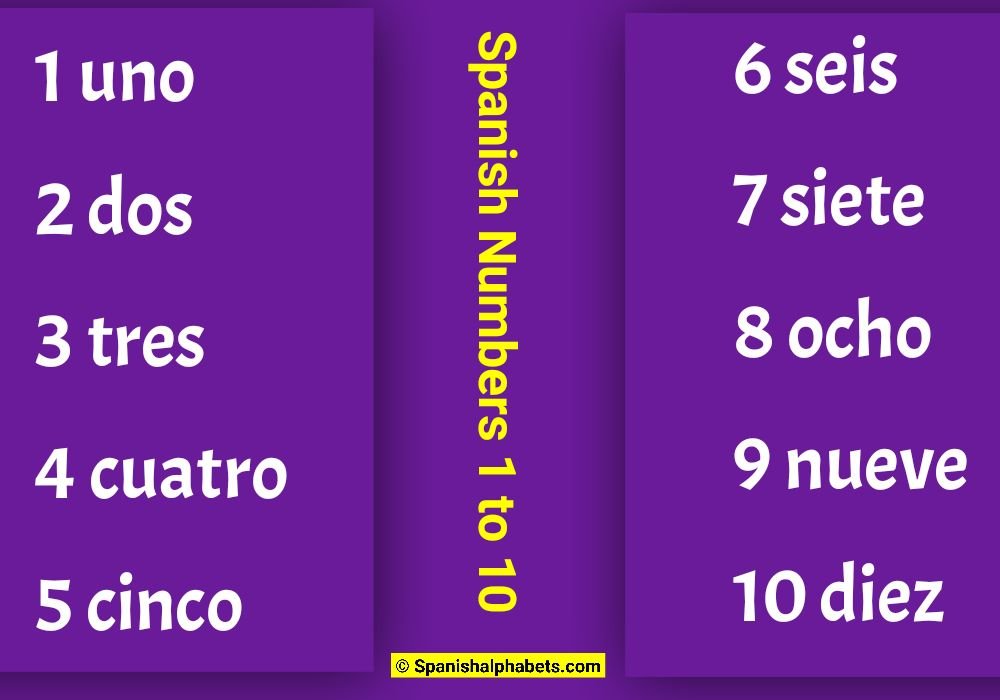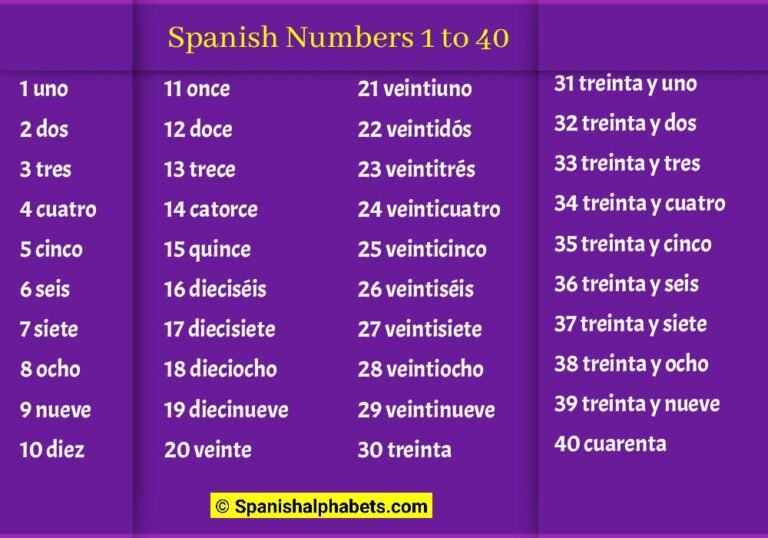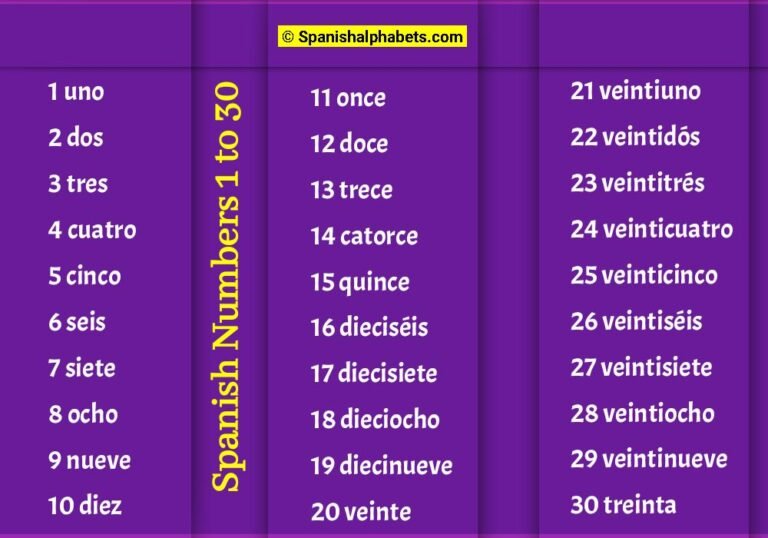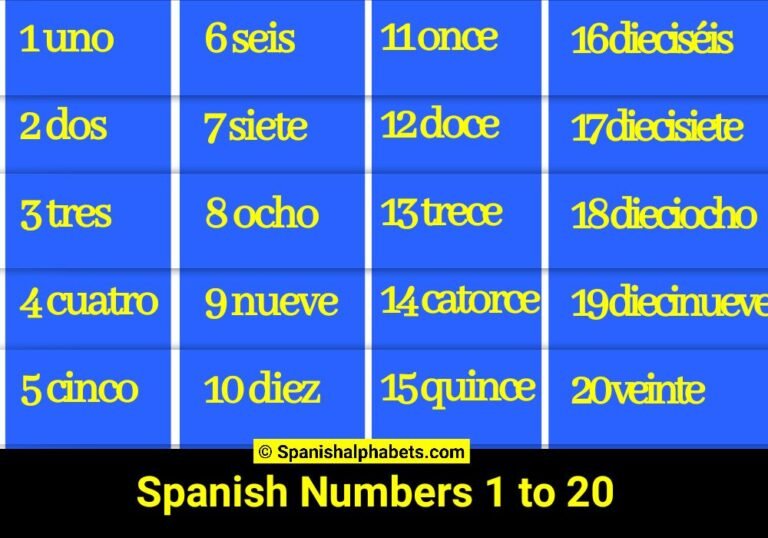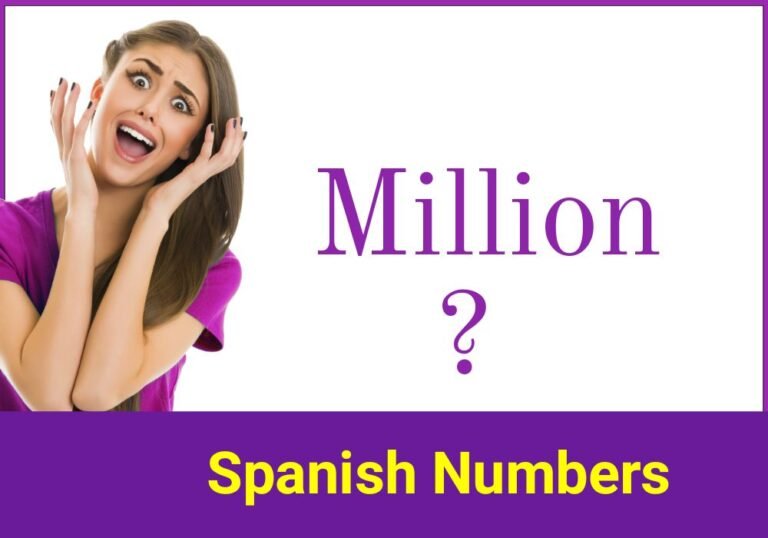Counting from 1 to 10 in Spanish isn’t just about numbers—it’s your first step into a vibrant culture!
Whether you’re planning a trip, impressing friends, or brushing up on language skills, these ten words unlock a world of confidence and connection.
In this article, discover simple tricks to master Spanish numbers, explore how American Spanish adds its own twist, and learn why counting can be a cultural adventure. Ready to make learning fun? ¡Vamos!
The following table lists the Spanish numbers 1 to 10.
Pronunciation
| No. | Spanish | Pronunciation |
| 0 | cero | say-ro |
| 1 | uno | oo-no |
| 2 | dos | dose |
| 3 | tres | trace |
| 4 | cuatro | kwat-ro |
| 5 | cinco | sink-o |
| 6 | seis | saze |
| 7 | siete | see-yet-eh |
| 8 | ocho | och-o |
| 9 | nueve | new-eh-veh |
| 10 | diez | dee-ace |
In Spanish, the numbers 1 through 10 are each represented by a single digit. The number 1 is represented by the digit “1”, the number 2 is represented by the digit “2”, and so on.
Each of these digits has a separate meaning and function in the language. For example, the number “1” represents the concept of unity. In contrast, the number “2” represents the concept of duality.
0 in Spanish – The Spanish word for zero is cero, which comes from the Arabic word ṣifr. In Spanish, the word “cero” is used to represent the concept of “zero” or “nothing.
1 in Spanish – The word “uno” is used for the number 1. This word is derived from the Latin “unus,” which means “one.” The word “uno” is also used as an indefinite article, meaning “a” or “an.”
The number “1” is pronounced as “uno.” When used as a pronoun, it means “one,” “a,” or “an.” It can also be used as an adjective, meaning “first” or “primary.” As a noun, “uno” refers to the number one.
2 in Spanish – The number “2” is pronounced as “dos.” This is because “2” is represented by the letter “d” in Spanish. The letter “d” is pronounced as a complex “d” sound, like in the word “dog.” The letter “o” is pronounced as a long “o” sound, like in the word “boat.”
3 in Spanish – “3” is pronounced “tres.” The word “tres” is derived from the Latin word for “three,” which is “tres.” In Spanish, the number “3” is also used to indicate the third person singular pronoun, as in “él es tres,” meaning “he is three.”
4 in Spanish – The number “4” is pronounced “cuatro.” The word “cuatro” comes from the Latin word “quattuor,” which means “four.” The number “4” is a cardinal number, indicating how many of something there are. In Spanish, “cuatro” is used for the cardinal and ordinal numbers “4.
5 in Spanish – The number 5 is “cinco.” It is pronounced like “sink-oh.” The number 5 is odd. It is a prime number.
6 in Spanish – The number 6 is pronounced as “seis.” The word “seis” is derived from the Latin word “sex,” which means “six.”
The number 6 is an even number and is one of the numbers that are divisible by 2. The number 6 also has the property of being a perfect number, which means it equals the sum of its proper divisors (1 + 2 + 3).
7 in Spanish – The number 7 in Spanish is “siete.” It is pronounced like “see-ETT-eh.” The number 7 is a lucky number in many cultures. It is considered a holy number in some religions, such as Christianity and Hinduism. In Spanish culture, 7 is often seen as a good luck charm.
8 in Spanish – The number 8 is “ocho.” This number is pronounced similarly to the English word “octopus,” with a slightly longer “o” sound.
The number 8 is considered a lucky number in many cultures, as it symbolizes good fortune and abundance. In Chinese culture, the number 8 is associated with wealth and prosperity.
In the Western world, the number 8 is often seen as a symbol of balance and infinity.
9 in Spanish – Nueve in Spanish is pronounced like “nway-vay.” It is written using the letter “n” and the number “9”. The word nueve means “nine” in Spanish.
Nueve in Spanish is 9. It is pronounced “noo-eh” and is the same in all Spanish-speaking countries.
10 in Spanish – In Spanish, the number 10 is diez. The word diez is derived from the Latin word decem, which means ten. Diez is a masculine noun, so it takes the masculine article el in front of it. When used as an adjective, diez agrees with the noun it modifies in gender and number.
How to easily and quickly count to 10 in Spanish?
It’s easy to learn how to count to 10 in Spanish. You can quickly and easily count to 10 in Spanish with just a little practice. Here’s how:
To start, let’s review the numbers in Spanish: one is uno (oo-noh), two is dos (dohs), three is tres (trehs), four is cuatro (kwah-troh), five is cinco (seen-koh), six is seis (sehs), seven is siete (syeh-teh), eight is ocho (oh-choh), nine is nueve (nweh-beh), and 10 is diez (dyehs).
Now that we know the numbers let’s put them together and count to 10 in Spanish.
The Different Ways to Count to 10 in Spanish
In Spanish, there are many different ways to count to 10. This can be unclear for beginners, but it’s easy to get the hang of it with some practice.
One way to count to 10 in Spanish is by using 1-10. For example, one would say “uno, dos, tres, quatro, cinco, seis, siete, ocho, nueve, diez.”
Another way to count to 10 in Spanish is by using 1-5 and then 10. For example, one would say, “uno, dos, tres, quatro, cinco, diez.”
Finally, another way to count to 10 in Spanish is by using the numbers 1-5 and then 7-10.
What are the Number One to Ten in Spanish?
In Spanish, the numbers one through ten are as follows: uno, dos, tres, cuatro, cinco, seis, siete, ocho, nueve and diez.
These numbers are essential to know for many reasons. First and foremost, they’re the basic foundation for all other numbers in the language.
Secondly, they’ll come up often in conversation – whether you’re discussing how many siblings somebody has or telling someone your phone number.
In Spanish, the numbers one through ten are: uno, dos, tres, cuatro, cinco, seis, siete, ocho, nueve, and diez.
“one” is used far more frequently than any other number in Spanish.
It’s used to express both singular and plural nouns and quantities. For example, “I have one book” would be “Tengo un libro.
How American Spanish Numbers 1-10 Differ from Traditional Spanish
If you’re learning Spanish, the numbers 1-10 have subtle differences when spoken in America compared to traditional Spanish.
While the pronunciations are mostly the same, there are a few notable exceptions.
For example, in traditional Spanish, the number “uno” is pronounced almost like “OO-noh,” with a very slight emphasis on the first syllable.
However, it’s more common in American Spanish to hear it pronounced as “OO-noh,” with a stronger emphasis on the second syllable.
The number “dos” is another one with a slightly different pronunciation in American Spanish. In traditional Spanish, it’s pronounced more like “dohs,” with a strong emphasis on the first syllable.
Why do Americans struggle to learn Spanish numbers up to 10?
Why do Americans struggle to learn Spanish numbers up to 10? A new study shows that Americans need help to learn Spanish numbers because they are not taught in schools.
The study by the University of California found that only 12% of Americans can correctly identify numbers up to 10 in Spanish.
This lack of knowledge can be attributed to Spanish being optional in most American schools.
In addition, most Americans speak English as their first language, making it difficult for them to learn a second language.
The study also found that Hispanics living in the United States are more likely to be able to correctly identify all of the numbers up to 10 in Spanish.
This is likely because many Hispanics grow up speaking Spanish as their first language.
Conclusion Points
In Spanish, the numbers one to ten are as follows: uno, dos, tres, cuatro, cinco, seis, siete, ocho, nueve, diez. Here is a little trick to help you remember them:
Counting in Spanish is easy once you know a few key phrases. For example, “uno” means “one,” “dos” means “two,” and so on. To count from one to ten in Spanish, recite the following: Uno, dos, tres, cuatro, cinco.
I then say seis after cinco since that’s how you count in Spanish (unlike in English where we say “five-six”) after seis comes siete which is just seven in English.
FAQs
Spanishalphabets.com’s FAQs section allows users to Spanish numbers 1 to 10, related questions, and answers.
This product is ideal for those who want to improve their knowledge of the Spanish language or for anyone who needs a quick reference guide for numbers in Spanish.
The Spanish numbers 1 to 10, related questions, and answers are laid out and easy to understand, making this product an essential tool for anyone learning or using Spanish.
Question (1) – How do you say 1 to 10 in Spanish?
Answer – The numbers 1 to 10 in Spanish are uno, dos, tres, quatro, cinco, seis, siete, ocho, nueve, and diez. When saying these numbers in Spanish, it is essential to remember that the stress is always on the second-to-last syllable.
Question (2) – How do you go to 10 in Spanish?
Answer: In Spanish, the number 10 is diez. To count to 10 in Spanish, you would say uno, dos, tres, cuatro, cinco, seis, siete, ocho, nueve, diez.
To go to 10 in Spanish, you need to know the numbers 1-10. Once you know the numbers 1-10, you can count to 10 in Spanish by saying the numbers in order.
Question (3) – How do you write Spanish numbers in words?
Answer: To write Spanish numbers in words, you need to know the basics of the Spanish number system.
The Spanish number system is based on the decimal system, which means that a combination of ten symbols represents every number.
The first nine symbols represent the numbers one through nine, and the tenth symbol represents zero. To write Spanish numbers in words, you combine these symbols to form the numbers you want to represent.
Question (4) – What is the Spanish word for 1?
Answer: The Spanish word for “1” is “uno.” This word is derived from the Latin “unus,” which means “one.” The word “uno” represents the number “1” in Spanish.
Question (5) – What is the Spanish word for 2?
Answer – In Spanish, the word for “2” is “dos.” This word is derived from the Latin word for “two,” which is “duo.”
In Spanish, the word “dos” is used both as nouns and adjectives. When used as a noun, it refers to the number two. When used as an adjective, it means “two of something,” such as “two apples.
Question (6) – What is the Spanish word for 3?
Answer – The Spanish word for three is “tres.” In Spanish, the number three is pronounced somewhat similarly to the English word “tree,” although the Spanish word has a bit of a rolling “r” sound at the end.
The word “tres” is also used in other Romance languages, such as French and Italian.
Question (7) – What is the Spanish word for 4?
Answer – The Spanish word for 4 is “cuatro.” This word is derived from the Latin “quattuor,” which means “four.”
The word “cuatro” is used in many Spanish-speaking countries, including Spain, Mexico, and Cuba. In some Spanish-speaking countries, such as Argentina and Chile, the word “cuatro” is also used to mean “fourteen.
Question (8) – What is the Spanish word for 5?
Answer – The Spanish word for 5 is “cinco.” This word is derived from the Latin “quinque,” which means “five.”
The word “Cinco” is used in many Spanish-speaking countries, including Spain, Mexico, and Chile.
In addition to being the word for 5, “cinco” can also be used as an adjective meaning “fifth.
Question (9) – What is the Spanish word for 6?
Answer: The Spanish word for 6 is seis. Seis is the cardinal number that follows cinco and precedes siete.
It is a natural number, though it is sometimes considered a composite number because it is the product of two primes (2 x 3). In Spanish, seis can be used as a noun and an adjective.
Question (10) – What is the Spanish word for 7?
Answer: The Spanish word for 7 is “siete.” This word is derived from the Latin word “septem,” which means seven.
In Spanish, this word is used to express the cardinal number seven. It can be used as both a noun and an adjective, and it is one of the most common words in the Spanish language.
Question (11) – What is the Spanish word for 8?
Answer: The Spanish word for 8 is “ocho.” It is pronounced similarly to the English word “octave.” The word “ocho” comes from the Latin word “octavus,” which means “eighth.”
Question (12) – What is the Spanish word for 9?
Answer: The Spanish word for 9 is nueve. This word is derived from the Latin word novem, which means nine.
Nueve is also the feminine form of the adjective nuevo, meaning new.
In Spanish, when a number is followed by a noun, the masculine form of the number is used if the noun is masculine, and the feminine form if the noun is feminine.
Question (13) – What is the Spanish word for 10?
Answer: The Spanish word for 10 is diez. Diez is a cardinal number that refers to the quantity of ten.
It is also the root word for the ordinal number dieciséis, which describes the sixteenth item in a series.

